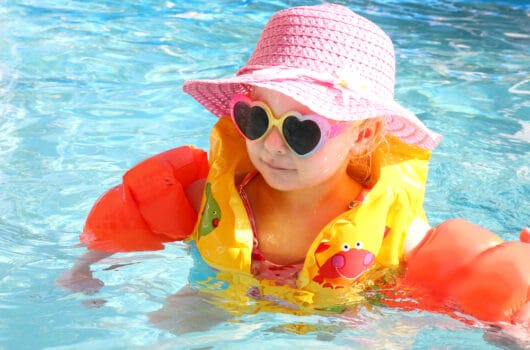Seeing your child swim for the first time is exciting but oh so nerve-racking. You want them to experience life to the fullest, but you also want to keep them safe and protected. Toddler swim vests are integral to letting your child splash and float safely before or as they learn to swim.
The wrong swim vest can actually put your child at risk, so we start the guide with the most important swim vest factors you need to consider. Then we give our recommendations for the top 10 toddler swim vests you can buy. In the end, we discuss how you can select the best swim vest for your toddler’s unique needs in even more detail.
- Toddler Swim Vest Factors to Consider
- Top 10 Best Toddler Swim Vests 2025
- 1. Best Overall Toddler Swim Vest: Speedo Kids Begin to Swim Classic Life Vest
- 2. Best Budget Swim Vest: Stearns Original Puddle Jumper Kids Life Jacket
- 3. Best Premium Swim Vest: O'Neill Child Superlite USCG Life Vest
- 4. Best for Young Toddlers: SwimSchool New & Improved Swim Trainer Vest
- 5. Best Swim Vest With Arm Floats: Body Glove Paddle Pals Swim Vest
- 6. Best Head-Supporting Life Jacket: Stearns Infant Classic Series Vest
- 7. Most Comfortable: Splash About Kids Go Splash Swim Vest
- 8. Best Float Swimsuit: Splash About Kids Floatsuit
- 9. Best Swim Vest With Sleeves: SwimSchool Swim Trainer Vest
- 10. Best Swim Vest With Removable Floats: Konfidence Buoyancy Swim Vest
- Selecting the Best Swim Vest for Your Toddler
- Happy Swimming!
Toddler Swim Vest Factors to Consider
Make sure to consider these key swim vest factors to guarantee your child’s safety and comfort.
Positioning
It may be surprising to realize, but the most important decision you’ll make is how the swim vest will position your child in the water.
- Front Facing: These vests put your child in a forward-facing, horizontal position that’s ideal for learning to swim.
- Upright: These vests keep your child vertical with their face out of the water, which is great for play or getting over a fear of water, but won’t teach them good swimming posture.
- Lying on Back: Vests that position your child lying on their back keep them safe in dangerous situations, but aren’t comfortable for swimming.
We discuss the benefits and drawbacks of each swim vest position in even more detail below.
Swim Vest or Life Jacket?
In the US, some swim vests also double as life jackets due to their approval from the Coast Guard (USCG). We’ve included some of those on our list, although they’re not always better than regular swim vests. We explain when each one might be better further down.
Weight
Most swim vests are recommended based on the weight range they accommodate, so we include that in every review. Choosing the wrong size will compromise your child’s safety and comfort, so after the reviews, we give a few tips on how to check fit.
Closure
Life jackets close either in the front or in the back, with zippers, buckles, or a combination. Many also include an additional crotch strap that buckles at the front. We discuss closure types in more detail later on, so you can consider which option will keep your child safest.
Designs
A fun design may help your toddler get excited about their swim vest. Consider what kind of design your child will like, or even better–let them decide!
Durability
You won’t feel safe with a swim vest that tears or fades easily. We don’t really discuss durability in our reviews because it was a baseline requirement for all of our toddler vest picks.
Sun Protection
Sun protection, which is denoted with a UPF rating, is a nice bonus that keeps your child’s skin safe from sunburn!
Comfort
If your kid isn’t comfortable in their vest, they’ll do anything to avoid wearing it. We selected comfortable vests that give your child a range of motion to enjoy the water. However, at times, a comfortable swim vest can be less safe, in which case we always prioritize safety.
Safety
Just because your child is wearing a swim vest doesn’t mean that they’re entirely safe from drowning. Make sure to follow the recommended safety tips below every time your family is in proximity to water.
Now that you understand the key factors, have a look at our selection of the best toddler swim vests for 2025!
Top 10 Best Toddler Swim Vests 2025
1. Best Overall Toddler Swim Vest: Speedo Kids Begin to Swim Classic Life Vest
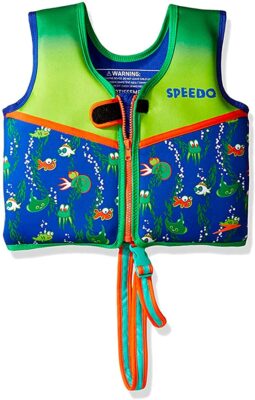
Editor’s Rating:
Quick Facts:
- Position: Front Facing
- Life Jacket: No
- Weight: 33-44 Pounds or 45-60 Pounds
- Closure: Front Zipper and Crotch Strap
- Designs: 8
- Sun Protection: UPF 50
- Material: Neoprene
This sleek-looking, full-coverage swim vest comes from the trusted swimwear brand Speedo. It might not be the most excitement-generating swim vest, but it’s a high-quality design that’ll help your child develop very important safety skills.
It’s the ideal pick for when your child first learns how to swim, with a weight capacity that usually accommodates 3-5-year-olds perfectly. It keeps toddlers floating very well, but facing forward so they still have to work a little to keep their face tilted back and out of the water. This is an important habit that every child learning to swim needs to develop on their own!
Getting your toddler into the vest is a breeze because it closes at the front. While we would normally worry about the child removing a front-closing swim vest on their own at the wrong time, this closure includes both a front zipper and a buckled strap that goes between the legs, so your toddler will still find it too tricky to remove.
A nice little mercy that this life vest offers is UPF 50, which means that it protects against both UVA and UVB rays. You’ll still have to reapply sunscreen to your child’s face, neck, and other areas of exposed skin, but their torso will be covered.
While this vest is made of neoprene, which tends to be very comfortable, it can still chafe a little if the fit is off or if your child has been wearing it for too long. If you expect that water playtime will last longer than an hour, we recommend taking periodic breaks or using it along with a full-coverage swimsuit.
If this design is a little too large for your toddler, we recommend the SwimSchool Swim Trainer Vest, which is available in an even smaller size.
Pros
- Excellent for swim lessons
- Sleek look
- Safe yet convenient zipper and buckle closure
- UPF 50 gives sun protection
Cons
- Can chafe if worn too long
2. Best Budget Swim Vest: Stearns Original Puddle Jumper Kids Life Jacket
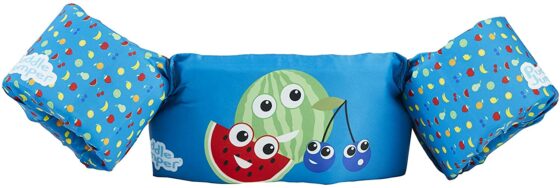
Editor’s Rating:
Quick Facts:
- Position: Upright
- Life Jacket: Yes, Type V/III
- Weight: 30-50 Pounds
- Closure: Back Buckle
- Designs: 23
- Sun Protection: No
- Material: Nylon
The Puddle Jumper swim vest is perfect for your fun family afternoon at the beach, waterpark, or by the lake!
Fitted with both arm floaties and a torso-hugging panel, this design keeps toddlers upright and feeling secure in the water. It assuages children’s fear of water and allows them to relax and enjoy splashing around.
It also assuages parental fears, since it’s rated by the USCG as a Type V/III personal flotation device. This means that it is appropriate for inland water or for when there’s a quick chance of rescue. Because it’s fitted with a back buckle, you know your child won’t be able to remove it.
The fit is most comfortable for toddlers on the higher side of the recommended weight. The upright position of the Puddle Jumpers allows them to feel held and secure as they move in the water, but with enough freedom and mobility.
However, if your child is around 35 pounds or under, the design won’t be as comfortable. The arm wings can restrict their movement and the torso panel can ride up to their chin. It’ll still keep them safe, but they won’t enjoy it as much.
It comes in plenty of adorable designs, so you can choose a jacket in your child’s favorite color or with their favorite sea creature, which will get them a little more enthusiastic about wearing it.
Finally, it’s important to mention that while both parents and toddlers love the Puddle Jumpers, swimming instructors are not big fans. This design is great for playing in the water and having fun, but it doesn’t put your child in a good position for actual swimming.
Pros
- Life jacket protection for beach or waterpark
- Toddlers find it fun and comfortable
- Won’t be easily removed by kids
- Many adorable designs to choose from
Cons
- Not suitable for swimming lessons
- Not comfortable for toddlers under 35 pounds
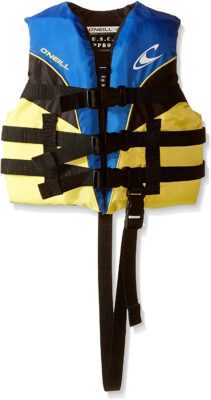
Editor’s Rating:
Quick Facts:
- Position: Front Facing
- Life Jacket: Type III
- Weight: 30-50 Pounds
- Closure: 3 Front Buckles, Crotch Strap
- Designs: 4
- Sun Protection: No
- Material: Polyester
Though it looks like a typical swim vest, this is actually a USCG rated life jacket. We love that toddlers can have an option that keeps their arms free while still guaranteeing more protection.
When you put it on your child you’ll immediately notice how sturdy and secure it feels. The three buckles are much harder for a child to undo compared to a zipper, but it’ll be very easy for you to get it on and off them. Surprisingly, despite being so heavy-duty, this design is quite comfortable, and the soft polyester shell is unlikely to chafe against your child’s skin, even after hours of wear.
You also don’t need to worry about your child adopting poor swimming habits because it’ll keep them in the correct posture. This makes it an ideal two-in-one since you can have it on hand for boating or waterparks, but your child can also wear it during swim lessons. It’ll keep them afloat if they fall in the water, but they’ll have the full mobility to swim back to you.
It’s available in 4 sporty color combinations, and while beauty is in the eye of the beholder, we don’t think these designs are as likely to appeal to a toddler as the cartoon prints on other vests. Because it’s so practical and versatile, we think this is a minor drawback.
Since it’s only a Type III life jacket, it’s not designed to keep the wearer’s face out of the water. That might be the right balance to strike if your child is a little older and has some control and confidence. If you’d rather have a life jacket that is guaranteed to keep their face out of the water, you might prefer the Stearns Heads-Up Vest, which is a safer Type II vest.
Pros
- Ultra-secure and durable design
- Type III life jacket
- Front-facing position for proper swimming
- Comfortable and non-chafing
Cons
- Plain, sporty designs
- Not as fun for splashing around
4. Best for Young Toddlers: SwimSchool New & Improved Swim Trainer Vest
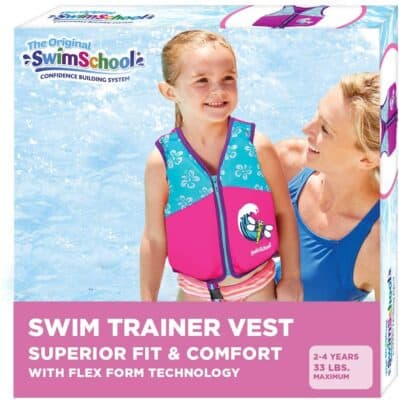
Editor’s Rating:
Quick Facts:
- Position: Front Facing
- Life Jacket: No
- Weight: Up to 33 Pounds or Up to 55 Pounds
- Closure: Front Zipper and Buckled Crotch Strap
- Designs: 4
- Sun Protection: UPF 50
- Material: Neoprene
It’s not easy to find a swim vest for toddlers under 30 pounds–especially if your aim is to teach them to swim correctly. That’s why we really appreciate this swim-focused, small-sized design from SwimSchool. Like the larger sized Speedo Kids Begin to Swim Vest, it’s designed to keep the wearer in a prone, front-facing position, which is ideal for learning to front crawl, and it offers a similar level of sun protection.
It may seem surprising, but the early toddler years are actually a fine time to start teaching your child how to swim correctly. A 3-year-old may not master the breaststroke, but they can acquire some basic water confidence and safety skills. Even the Center for Disease Control agrees that children as young as 12 months can benefit from swimming lessons, which are considered a layer of protection against accidental drowning.
Because of that, this vest won’t keep their head or mouth totally out of the water, so you need to consider whether your child will be able to lift their head on their own. If your toddler is more likely to fuss or struggle while wearing it they’re also more likely to run into issues like getting flipped over or getting a mouth full of water. If that’s the case, the Body Glove Paddle Pals Swim Vest might be a more appropriate choice.
As far as drawbacks go, this vest isn’t very skin-friendly if worn for too long, so your child shouldn’t wear it continuously for longer than an hour or two. There are 4 color options to choose from, each one with a cute animal cartoon, so while more options might generate more excitement, there’s still enough here to please most children.
Pros
- Perfect for very small toddlers
- Ideal for those life-saving early swim lessons
- Offers sun protection
Cons
- Won’t keep face out of water
- May chafe if worn for long
5. Best Swim Vest With Arm Floats: Body Glove Paddle Pals Swim Vest
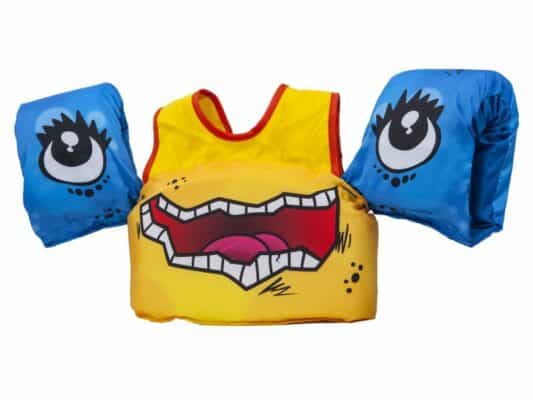
Editor’s Rating:
Quick Facts:
- Position: Upright
- Life Jacket: Type III
- Weight: 30-50 Pounds
- Closure: Back Buckle
- Designs: 12
- Sun Protection: No
- Material: Polyester
This is another fantastic option if you’d like a swimming vest that also functions as a USCG-approved life vest. It features a full vest, with a harness that gives added security at the shoulders, and flotation wings that will support your child’s arms. It comes in incredibly cute and well-thought-out designs that extend from the torso to the arm floaties.
It’s a great fit for children who are afraid of getting in the water for the first time because the material envelopes them and gives them a feeling of protection. Once in the water, it keeps them upright so they won’t accidentally get a mouthful of water, which is a major deterrent with first-time water experiences.
This is a similar choice to the slightly more affordable Puddle Jumpers. However, because of the added shoulder harness, it doesn’t ride up or bounce too much even if your child is on the lower end of the weight range. Older toddlers might not need the added shoulder harness and may even find it uncomfortable, in which case Puddle Jumpers would be the better choice.
Since it’s a life jacket, we find that it’s better for general safety near the water, but it’s not a good learner aid. When wearing it, your child won’t have to do as much work as with a vest like they would with the SwimSchool Swim Trainer Vest. Once your child starts their swimming lessons, we strongly recommend transitioning them to a regular vest that leaves the arms free.
Pros
- USCG-approved life jacket
- Coverage that gives children a sense of security
- Shoulder harness ensures better fit on small children
- Many adorable, clever designs
Cons
- Not a good aid for swim lessons
- Biggers toddlers may dislike shoulder harness
6. Best Head-Supporting Life Jacket: Stearns Infant Classic Series Vest

Editor’s Rating:
Quick Facts:
- Position: Lying on Back
- Life Jacket: Type II
- Weight: 30 Pounds and Less, 30-50 Pounds
- Closure: Front Zipper, Buckle, and Crotch Strap
- Designs: 2
- Sun Protection: No
- Material: Nylon
This is the safest life jacket on our list since it qualifies as a Type II life jacket by the US Coast Guard. This means that it offers extra protection and that it’ll do the best job of keeping your toddler’s head out of the water. If your family goes boating frequently then we highly recommend opting for this pick.
The design will allow your toddler to float on their back with ease, and it features a head-rest that offers a lot of support. There is also a strong strap attached to the head-rest, which allows you to fish your child out of the water quickly and easily if the need arises. It comes with a very thorough instruction booklet that will give you all the important safety information you need to know, like how to fit and test out the life jacket.
Even if you don’t participate in activities that require a Type II life jacket, you might still prefer this pick. For example, we think it’s a nice option for a toddler who isn’t intensely energetic and would be more likely to enjoy floating leisurely on their back.
However, if your toddler likes to splash around a lot, you might prefer the Body Glove Paddle Pals Swim Vest, which keeps toddlers upright rather than on their back.
If your toddler is ready for swim lessons but you want a USCG approved life jacket, you might prefer the O’Neill Superlite Life Vest, instead.
Pros
- Type II life jacket is the most secure on our list
- Head-rest allows toddler to float on their back
- No risk of head getting in the water
- Strap allows you to fish child out of the water quickly
Cons
- Not great for learning to swim
- Not as fun to splash around in
7. Most Comfortable: Splash About Kids Go Splash Swim Vest
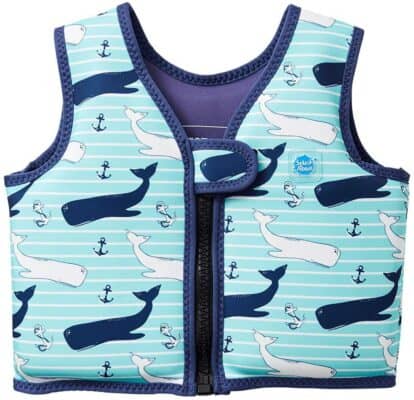
Editor’s Rating:
Quick Facts:
- Position: Front Facing
- Life Jacket: No
- Weight: (S) 25-33 Pounds, (M) 33-48 Pounds, (L) 48-66 Pounds
- Closure: Front Zipper and Buckle
- Designs: 4
- Sun Protection: 50 UPF
- Material: Neoprene
Most swim vests don’t cause chafing when they’re worn for a limited time–it’s only after an hour or two that issues can crop up. If you have plans for a full day at the waterpark or your child has sensitive skin, having an ultra-soft neoprene vest like this can be a great relief. This design is the softest and gentlest of all of our picks, so it’s the least likely to cause chafing or irritation!
Otherwise, it’s a fairly standard swim vest that’s suitable for swim lessons, even for very small toddlers. It keeps the arms free and it guides your child towards a horizontal position. It won’t keep your child’s face out of the water, so consider their abilities before purchasing it.
Unlike other swim vests on our list, this one is not fitted with a crotch strap, which can either be a major drawback or a major benefit. The crotch strap is an important safety element that secures the swim vest to the child from below and prevents it from riding up over their face in the water.
Unfortunately, crotch straps are often responsible for uncomfortable chafing between the legs, so while this swim vest is much more comfortable than many others on the list, it’s also a little less safe. For instance, your child will be able to remove it on their own very easily, and if the fit is even just a little too large it can ride up dangerously. If you choose this vest, make sure to check the fit thoroughly and keep a close eye on your child every time they’re in the pool.
Pros
- Gentle, non-chafing material
- Good choice for swim lessons
- Comfortable for multiple hours in the water
Cons
- Not as safe as less comfortable vests
- Won’t keep child’s face out of water
- Very easy for child to remove
8. Best Float Swimsuit: Splash About Kids Floatsuit
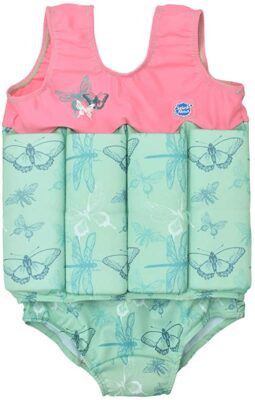
Editor’s Rating:
Quick Facts:
- Position: Front Facing or Upright
- Life Jacket: No
- Weight: Age-Based Sizing, 1-6 Years
- Closure: Back Zipper
- Designs: 2
- Sun Protection: UPF 50
- Material: Nylon
If you want your child to have the maximum amount of mobility but with added buoyancy, consider a float suit like this one! It’s basically a swimsuit with 16 removable floatation pads that allow you to control the level of buoyancy based on your toddler’s skill and weight.
The most major benefit of this float suit is that it’s just so comfortable. It’s not bulky at all, and it can’t rub against your child so there is no risk of chafing. Because there is no padding added to the arms or over the shoulder they have total freedom of movement so they can swim without feeling restricted. The only difficult part is actually putting it on and taking it off your child–if you want something more flexible, you may prefer the Splash About Swim Vest instead.
With added freedom, there are also some added risks. This kind of design doesn’t keep the child’s head out of the water, so you’ll definitely need to keep close when they swim. It doesn’t position them specifically to face forward or upright, so there’s a bit of a learning curve when finding balance in the water. You can partially adjust for that by adding or removing foam pads, but that also takes some trial and error.
Finally, it might not feel like enough protection if your main goal is to help your child get over a fear of the water. Bulkier swim vests actually allow them to feel covered and protected, while a floatation suit might not give them that sense of security.
As far as the design goes, it looks like a one-piece girls’ bathing suit, but it’s also available in a more unisex striped print that can work for little boys. It’s sized based on age, but the sizes can run a little small, so go up a size if you’re not certain about the fit.
Pros
- Maximum mobility and comfort
- No risk of chafing
- Adjustable buoyancy
Cons
- Has a bit of a learning curve
- Not enough for children scared of water
- Requires more effort to put on and remove
9. Best Swim Vest With Sleeves: SwimSchool Swim Trainer Vest
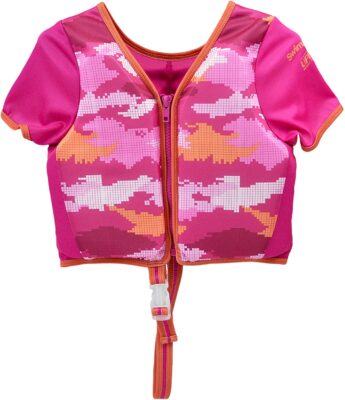
Editor’s Rating:
Quick Facts:
- Position: Front Facing
- Life Jacket: No
- Weight: Up to 33 Pounds, Up to 50 Pounds
- Closure: Front Zipper and Crotch Strap
- Designs: 2
- Sun Protection: 50 UPF
- Material: Nylon
This swim vest offers great protection thanks to its sleeves. Not only does it keep your child safe in the water, but it also protects them from the sun.
It’s a typical vest design that keeps your child in a front-facing position, but the addition of sleeves has a couple of important benefits: first, it offers added sun protection since it covers your child’s shoulders, back, and upper arms more thoroughly. These are areas where sunburn is most common, so the added protection can be a big bonus, especially if the child is fussy about sunscreen.
The second benefit is the lack of chafing. The way the foam pads are built into the soft swimsuit fabric prevents friction, especially around the arms and neck. There is still a slight risk of chafing from the crotch strap, but we think it’s worth it since it prevents the vest from floating up.
The final benefit is that it’s not very easy for a child to take off. It’s worth purchasing if you’re worried that your toddler might remove their swimming vest and put themselves at risk when you’re not looking. Unfortunately, it also means that you’ll have to work a little harder to get them into the vest in the first place.
Now, admittedly, this is one of the bulkiest options on our list. The foam pads are visible through the fabric of the vest, which isn’t as cute as a more streamlined design. Additionally, it has the same limitations as other front-facing designs, meaning that your child will still have to do a bit of work while wearing it.
Pros
- Additional sun protection to shoulders and upper arms
- Lower risk of chafing
- Harder for a child to remove
Cons
- Slightly difficult to put on a child
- Bulky design
- Won’t keep toddler’s head out of water
10. Best Swim Vest With Removable Floats: Konfidence Buoyancy Swim Vest
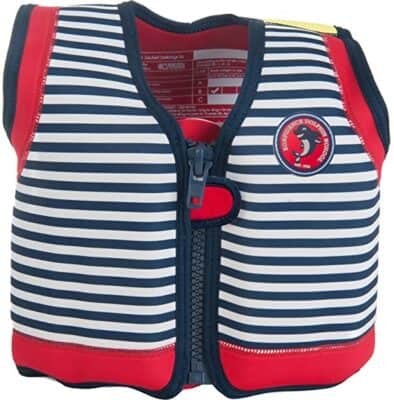
Editor’s Rating:
Quick Facts:
- Position: Front Facing
- Life Jacket: No
- Weight: 26-44 Pounds, 44-55 Pounds, 55-66 Pounds
- Closure: Front Zipper
- Designs: 9
- Sun Protection: UPF 50
- Material: Lycra/Neoprene
The Konfidence Swim Vest might appear similar to a few other vests on this list, but it’s actually quite different. While most other swim vests are fixed when it comes to the level of buoyancy, this design is totally adjustable.
The back is fitted with eight float compartments, and each float can be removed to change the level of buoyancy. This gives you a lot of control and allows you to keep using the same vest as your child grows and as their swimming skills improve. Surprisingly, when your child is younger, you’ll probably want fewer floats in the jacket to prevent them from being lifted up too high in the water.
Even with all of the float pieces in the jacket, the level of buoyancy isn’t intense, so children on the higher side of the weight range won’t float high in the water. This, combined with the fact that it promotes a front-facing position, means that it’s definitely more of a learning aid than a safety device, and you need to stay nearby when they’re wearing it. It doesn’t include a crotch strap, so while your child won’t experience chafing, they might find this vest worryingly easy to remove.
A final thing we appreciate is the vest design. It’s printed with stripes and polka dots that have a unique charm. Even better, instead of having the design extend all around the vest, the back panel is colored bright yellow, which will make it easy to spot your child from behind at a busy pool.
Our final note is regarding price: this vest is slightly more expensive than most other options on our list, but if you think your child will benefit from the adjustable buoyancy and added comfort, it might be a worthy purchase anyway.
Pros
- Great for smaller children
- Can be adjusted as your child’s swimming skills develop
- Easy to spot bright yellow back
- Elegant but playful prints
Cons
- Not very buoyant for heavier children
- No crotch strap
- A little pricey
Selecting the Best Swim Vest for Your Toddler
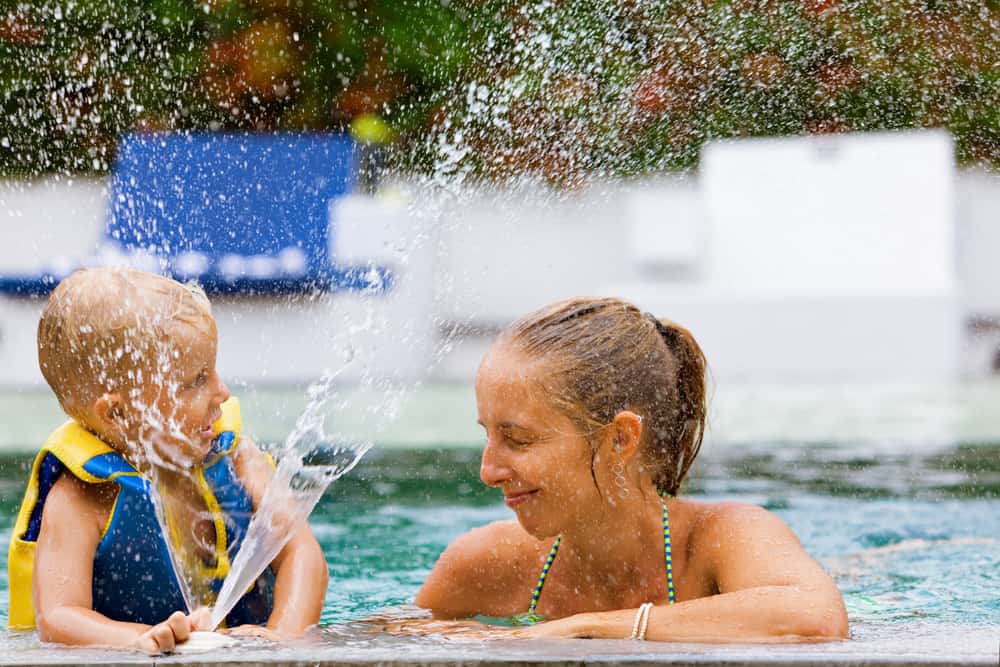
There’s quite a lot to consider when selecting your toddler’s swim vest, so with this guide, we’d like to help you narrow down your selection.
Swim Vest Positions
The direction in which your child’s vest positions them in the water will have an unexpectedly large effect on their overall experience and the habits they’ll form. Each position has its benefits, drawbacks, and the different situations when it’ll be most suitable, so we’d like to help you figure out which will be best for your child.
Front Facing
If you take the term “swim vest” literally, then a front facing swim vest like the Speedo Kids Begin to Swim Vest is the best choice. A front-facing vest positions your child horizontally in the water, which is also the correct position for swimming properly. That’s why most of the vests on our list are part of this category.
This kind of design doesn’t keep the child’s head out of the water, so they’ll need to learn to tilt their head back all on their own. A lot of children don’t like this, because it takes effort on their part, while for parents it can be a little scary to see their child with their face so close to the water. However, this is very important practice when they’re learning to swim, since learning to raise their head all on their own can save them from drowning in the future, even if they’re not wearing a swim vest.
If your children are not ready for swimming lessons yet or they’re a little afraid of water, this might not be the best choice. However, if your goal is their future sufficiency, control, and safety in the water, it’s better to go with this educational option.
Upright
Upright swim vests like Puddle Jumper or Body Glove Paddle Pals Swim Vest are fitted with arm floats. This design keeps children upright or vertical by having the arm floats act as their main buoyancy aid. They are incredibly popular because they keep toddlers’ heads out of the water and they’re often approved as life jackets.
They’re a great option for the water park or the beach where your child is going to be focused on playing rather than swimming. They’re also very convenient for younger toddlers that aren’t ready for swim lessons. The support around the torso and arms hugs the child which helps them feel protected. If your child is scared of water, letting them in with this kind of comfortable swim vest can alleviate their fears and build their confidence.
However, we don’t recommend relying on an upright swim vest too often, especially in regular pools once it’s time for them to learn to swim. Some swimming instructors even warn against these kinds of swim vests. Upright vests might be comfortable, but they don’t put your child in a position that’s conducive to swimming. The risk is that if they’re used to being upright in the water and they accidentally fall in without a swim vest, they won’t be able to float and will be at a higher risk of drowning.
Floating on Back
Swimming vests that position your child so they’re floating on their back will offer the most protection from drowning, which is why they’re usually approved as life jackets. They prevent any risk of your child’s face going underwater, so they can save their lives in dangerous situations.
With that said, they’re not ideal as swimming vests, which is why our only pick from this category is the Stearns Heads-Up Vest. While your child will be able to move around in them, it’s not going to be particularly comfortable. We’d suggest picking up this kind of jacket only if your family participates in a lot of non-swimming water activities that require a life jacket or if you think your toddler will enjoy just floating around and “chilling” in the water.
Choosing a Swim Vest vs. Life Jacket
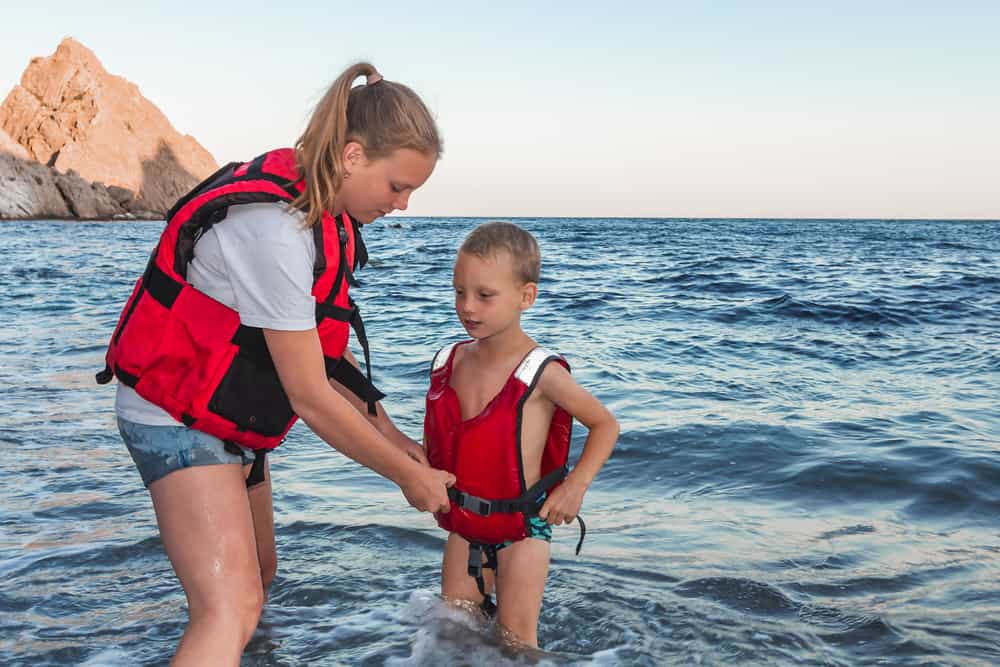
If you’re trying to decide between a simple swim vest or a swim vest/life jacket hybrid, it’s important to understand the differences between the two as well as the similarities.
Swim Vests
Swim vests are simple flotation garments that boost your child’s buoyancy when they’re in the water. They’re fantastic for pools, but they won’t suffice as life-saving devices in natural bodies of water.
They don’t have to be tested or approved by a regulatory body, which is why it’s extra-important to choose one from a reputable brand that can do its own internal quality-assurance, like Speedo or SwimSchool. Swim vests are more likely to put your child in a front-facing position, so they’re usually a better learner’s aid for swim lessons.
Life Jacket
To count as a life jacket in the US, a product has to be approved by the US Coast Guard. This level of testing is the only inherent difference to life jackets, so while a swim vest is designed to add buoyancy, a life jacket is guaranteed to do so. Because of this, some public pools and water parks require that all children wear a USCG-approved life jacket. You might prefer a life jacket/swim vest hybrid to be able to access attractions that have those restrictions in place.
It’s extremely important to understand the limitations of a life jacket because having a false sense of security about the vest’s function is more dangerous than not having your child wear one at all.
There are a few different types of life jackets for different situations, but most commercial toddler life jackets also marketed as swim vests have a Type III rating, which is appropriate for inland, non-tumultuous waters where there is supervision and rescue can be swift.
While some, like the Body Glove Paddle Pals Swim Vest, are designed in a way that keeps the child’s head out of the water, it’s not a mandatory requirement, and the vest won’t necessarily flip the child over if they’re unconscious or face down like a Type II life jacket. That’s why there are also front facing life jackets like the O’Neill Superlite Life Vest available, which are not very different from typical learner’s swim vests.
We did include the Stearns Heads-Up Vest on our list, which is a type II life jacket that offers more security and does an amazing job of keeping a child’s head out of the water. We acknowledge that it’s not a great choice for swimming.
If safety is your number one priority and your family spends a lot of time participating in activities like boating or kayaking, check our guide to life jackets for infants and toddlers, which focuses on safety rather than swimability, and includes even more Type II life jacket options.
Even if you buy your toddler a Type II life jacket, it’s still not a total guarantee of their safety and it certainly doesn’t count as a replacement for close adult supervision.
Making Sure Your Toddler Won’t Remove Their Swim Vest
In an ideal world, your child will love their swim vest so much that they’ll be happy to wear it and the closure system won’t matter at all! Sadly, that’s not always the case.
Explain the importance of the swim vest to your child and try to find them a comfortable fit that they won’t want to remove. Even then, a good closure is helpful, especially if your toddler likes to take clothes off on a whim or hates feeling restricted.
Back Closure
Many parents prefer a swim vest with a buckle at the back like the Puddle Jumper. The closure is usually just a single buckle, so it’s very easy for parents to buckle and unbuckle the swim vest. On the other hand, it’s not easy at all for children, who can’t reach the back buckle.
Front Closure
Next, we have front closures, which are more common on front-positioning swim vests like the Speedo Kids Begin to Swim Vest. Because children can reach the front easily, the closures themselves have to be more complicated.
These vests are usually fitted with a zipper, a buckle or added front strap, and a crotch strap that goes between the child’s legs. For most toddlers, this is far too complex to remove, but if your child is enterprising, this might not be a risk you’re willing to take.
Other Removal Factors
We’ve already mentioned crotch straps, but there are other factors that can come into play when it comes to how easy a vest is to remove. First, there’s the question of a zipper or buckle. A combination of the two is the most secure, but in general, it’s more difficult for toddlers to undo a buckle than a zipper.
Another factor that makes removal harder is the addition of sleeves, like on the SwimSchool Trainer Vest with Sleeves or even a full swimsuit like Splash About Float Suit. These tight fits require more dexterity to remove, and your child won’t be able to get rid of them quickly or easily.
Swim Vests vs. Floaties
While a swim vest is affixed to your child’s body, a floatie is any kind of buoyancy aid that’s separate from your child, including inflatable armbands, tube floats, and some inflatable toys. Your child can remove or let go of them at any time, so they’re not a good barrier to drowning. They can still work as a learning tool or as a toy (including in combination with a swim vest) to make your kid’s time at the pool more enjoyable. If you’re looking for other ways for them to have more fun in the pool, we have a full article about the best pool toys for kids.
We have a full article about pool toys.
It’s important to mention that armbands, specifically, will put your child into a vertical position, which has its own pros and cons as we discussed earlier.
Checking Your Toddler’s New Swim Vest
Once you have your toddler’s new swim vest in your hands, there are a few things you should check to make sure that they’ll be safe and comfortable in it.
- The first thing to check is the fit! A vest that’s too small might not keep your child buoyant in the water, while an overly large one can ride up or cause painful chafing.
- Have your child try the vest on, and adjust the various buckles and straps. The fit should be snug and secure, especially around the chest, but it shouldn’t be tight.
- Show some excitement and enthusiasm about your child’s new vest during the try-on, so that they can also get excited about wearing it.
- Try to move the vest up and down, to see if it rides up at all. If the front of the vest moves up past your child’s chin, the fit is dangerously loose. If the swimming vest is also a life jacket, you should actually lift your child up by the shoulders of the vest to check for this.
- If the fit is off, it’s better to return the swimming vest and purchase a new one in a better size. A swim vest that doesn’t fit your child properly can be painful or even dangerous.
- If the fit seems fine, let your child wear the vest around the house, to allow them to get used to it.
- This also allows you to check if there are any contacts of friction that you might not notice if they only wear it for a few minutes. Even very high-quality materials can rub against a child’s underarms, neck, or between the legs.
- If the fit is otherwise good, but there’s some friction, you can have your child wear a T-shirt or a full-coverage swimsuit under the vest when it’s swim time.
- Finally, check the swim vest for buoyancy before allowing your child to wear it in water. Test it in the pool or even in a bathtub (assuming it’s large enough) to ensure that it floats well on its own.
Toddler Swim Safety Tips
According to the American Academy of Pediatrics (AAP), drowning is the number 1 cause of accidental death in children ages 1-4, and it can happen even in extremely shallow water. No matter which swim vest you choose, you need to maintain the same level of vigilance every time your child is in proximity to water.
- Make sure an adult is always keeping an eye on your toddler. It only takes a few minutes of distraction for your child to run off on their own and for the worst to happen.
- When not actively swimming, make sure there are barriers to water access. 69% of toddler drowning incidents happen during non-swim times when the parents are less likely to pay attention. If your family has a pool, keep it covered when not in use, and consider also installing a fence, per AAP recommendations.
- If your family visits a new place, scan the area, and consider whether there are any sources of water that could pose a risk. Come up with strategies that restrict your child’s access, like keeping them indoors or having someone guard the water.
- Having your child take swim lessons also counts as a layer of protection against drowning, and it’s absolutely essential by the time they’re 4 years old. If your child is ready for swim lessons, we recommend choosing a vest like the Speedo Kids Begin to Swim Vest or the O’Neill Superlite Life Vest that’s designed to help them along.
- With the essential safety tips out of the way, remember that there are other potential concerns when spending time near water! For example, protect your children from sunburn and increased risk of skin cancer by having them wear UPF rated garments and applying sunscreen to their exposed skin.
Happy Swimming!
Whether it’s a question of getting over their fear of water, learning to swim, or staying afloat in difficult situations, a swim vest is an essential contraption that will boost your toddler’s skills and can even save their life. If you’re looking for other ways to prepare your child for the water, you can also read our article about the best swim diapers. Now that you understand what kind of swim vest is right for which situation, you can empower your child and get them swimming happily for the decades to come!
